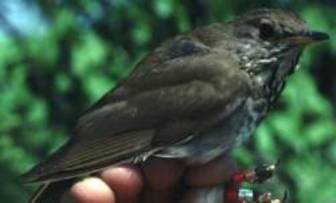Bicknell's thrush
The Bicknell's Thrush, Catharus bicknelli, is a medium-sized thrush, at 17.5 cm and 28 g . It was named after Eugene Bicknell, an American amateur ornithologist, who discovered the species on Slide Mountain in the Catskills in the late 19th century.

The Bicknell's thrush is classified as Vulnerable (VU), considered to be facing a high risk of extinction in the wild.
The Bicknell's Thrush, Catharus bicknelli, is a medium-sized thrush, at 17.5 cm (6.9 in) and 28 g (1 oz). It was named after Eugene Bicknell, an American amateur ornithologist, who discovered the species on Slide Mountain in the Catskills in the late 19th century. Adults are olive-brown on the upperparts, slightly redder on the tail. The underparts are white with gray on the flanks; the breast is greyish brown with dark spots. They have pink legs, a faint grey eye ring, and gray cheeks. More
Thrush, the Bicknell's Thrush has one of the most restricted breeding and wintering ranges of any North American bird. More
Bicknell's Thrush on a nest Have you seen a Bicknell's Thrush? Consider adding it to eBird to help us track locations. - Would you like to help monitor populations? In the U.S. More
Bicknell's Thrush was recognized as a distinct species only in 1995. More
Bicknell's Thrush Habitat Model go to: USFWS Gulf of Maine Watershed Habitat Analysis go to: Species Table Feedback: We welcome your suggestions on improving this model! Draft Date: March, 2001 Species: Bicknell's thrush, Catharus bicknelli. Historically was regarded as a subspecies of the gray-cheeked thrush (Ouellet 1993). Use of Study Area Resources: Reproduction. More
● Similar species: Bicknell's Thrush: Gray-cheeked Thrush is larger, with olive-gray upperparts, olive-brown tail, and gray wash on breast, sides, and flanks. Flight Pattern Relatively swift direct flight with somewhat jerky wing strokes. Bicknell's Thrush Breeding Male Body Illustration● Range & Habitat: Bicknell's Thrush: Breeds from southern Quebec and the Maritimes south to northern New England and northern New York. Preferred habitats include alpine areas near tree line. More
The Bicknell's Thrush is of very high importance because of its extremely limited range, small overall population, and its extreme vulnerability to deforestation in its limited winter range. Identifying large and stable populations of this species, as well as determining its precise habitat and area requirements, especially sensitivity to silvicultural practices and other disturbances, will be important for conserving populations. Description Male: Upperparts olive-brown with a slightly more reddish tail and primaries, indistinct eye-ring. More
, the Bicknell's Thrush is among the least-known breeding birds in North America. Long considered a subspecies of the Gray-cheeked Thrush, it was afforded its own species distinction in 1995. Restricted to high elevation forests, this cousin of the American Robin shuttles between Caribbean and northeastern mountains to breed. Appearance: The Bicknell's Thrush is a medium-sized songbird measuring about 6.75 inches long with an 11.5 inch wingspan and weighing 1.1 ounces. More
in which Bicknell's Thrushes dwell have kept their habits long wrapped in mystery. —Wallace 1939: 285 Figure 1. Distribution of Bicknell's Thrush. Patchy distribution throughout its range makes exact delineation difficult. See text for details. The nasal, gyrating song and plaintive calling of Bicknell’s Thrush are familiar to few birders or ornithologists. More
Bicknell's Thrush Habitat and Climate Change We have created a detailed map of the entire U.S. breeding habitat for Bicknell's Thrush. It was published in The Wilson Bulletin, a quarterly, peer-reviewed journal of ornithology in 2005. For the first time, we can reliably predict where this rare bird breeds and where it is likely to be absent. More

Original source: Kent McFarland
-Kent McFarland -Author: Kent McFarland
Permission: Some rights reserved
Family : Turdidae
Genus : Catharus
Species : bicknelli
Authority : (Ridgway, 1882)

